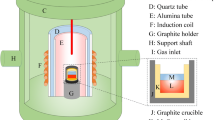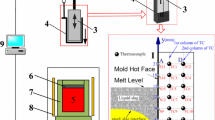Abstract
Three different mold slags have been sampled in dependence of time during slab casting of TRIP steel, and compositional changes have been analyzed. Mass transfer coefficients governing the decrease of silica and increase of alumina have been determined. Moreover change of manganese content was investigated in dependence of the initial manganese content of the mold powder which was close to zero for one of the powders investigated. The following findings have been revealed: Mass transfer coefficients are rising with increasing elapsed time or decreasing silica content, respectively. An initial increase of manganese content by oxidation from the steel followed by later reduction has been observed for the manganese free mold powder. For interpretation of these findings, further simulation according to an effective equilibrium reaction zone model was performed. It was revealed that the primary impact of the steel flow at the steel/slag interface close to the mold wall followed by a stratified flow is of major importance for the phenomena observed. Further results make it possible to predict the steady state composition and show that steady state silica content is nonzero in any case. Moreover, for the mold powders investigated here, it was concluded that manganese content does not decrease silica reduction.
Zusammenfassung
Die experimentell ermittelte Veränderung der chemischen Zusammensetzung von drei Gießschlacken beim Vergießen von TRIP Stahl diente als Grundlage zur Bestimmung der Stoffübergangskoeffizienten, die für die Beschreibung der SiO2-Verminderung und Al2O3-Erhöhung maßgeblich sind. Außerdem wurde die Veränderung des MnO-Gehaltes untersucht, wobei ein Gießpulver praktisch MnO-frei war. Es hat sich gezeigt, dass die Stoffübergangskoeffizienten mit fortschreitender Zeit bzw. sinkendem SiO2-Gehalt steigen. Bei dem MnO-freien Gießpulver konnte ein anfänglicher Anstieg des MnO-Gehaltes beobachtet werden, sowie ein darauffolgender Abfall. Zur Interpretation dieser Ergebnisse wurde ein thermochemisches Prozessmodell erstellt. Dabei zeigte sich, dass die Schichtenströmung des Stahls in der oberen Konvektionswalze entlang der Phasengrenze Stahl/Schlacke zu einer Verminderung des Al-Gehaltes führt, wodurch eine Oxidation von Mn möglich wird. Weitere Ergebnisse gestatten die Berechnung der stationären Zusammensetzung und zeigen, dass der stationäre SiO2-Gehalt nicht null sein kann. Für den hier untersuchten Gießprozess ist eine Verminderung der SiO2-Reduktion durch einen Mangangehalt des Gießpulvers nicht möglich.








Similar content being viewed by others
References
Münch, A. C.; Petry, S.; Schulz, K.; Senk, D. G.: Untersuchungen zur zeitlichen chemischen Veränderung von Gießpulvern, in: 21. Aachener Stahlkolloquium, Aachen, 2006, pp 189–200
He, S.-P.; Wang, Q.; Zeng, J.-H.; Zhang, M.; Xie, B.: Properties control of mold fluxes for high aluminum steel, Journal of Iron and Steel Research, 12 (2009), no. 21, pp 59–62
Klug, J. L.; Heck, N. C.; Silva, D. d. R; Vilela, A. C. F.: Mould slag alumina pick-up due to chemical reactions at the metal-slag interface in the continuous casting process, 65th ABM International Congress, Rio de Janeiro, 2010, pp 1973–1980
Yu, X.; Wen, G.-H.; Tang, P; Ma, F.-J.; Wang, H.: Behavior of mold slag used for 20Mn23Al nonmagnetic steel during casting, Journal of Iron and Steel Research International, 1 (2011), no.18, pp 20–25
Wang, Q.; Qiu, S.; Zehao, P.: Kinetic analysis of alumina change in mold slag for high aluminum steel during continuous casting, Metallurgical and Materials Transactions B, 2012, pp 424–430
Thomas, B. Q.; Yuan, Q.; Sivaramakrishnan, S.; Vanka, S. P.: Transient Fluid Flow in a Continuous Steel-Slab Casting Mold, JOM-e (2002), http://www.tms.org/pubs/journals/JOM/0201/Thomas/Thomas-0201.html
Ende, M.-A.; Kim, Y.-M.; Cho, M.-K.; Choi, J.; Jung, I.-H.: A Kinetic Model for the Ruhrstahl Heraeus (RH) Degassing Process, Metallurgical and Materials Transactions B, 2011, pp 477–489
Jung, I.-H.; Van Ende, M.-A.; Kim, D.-G.: Thermodynamic modeling of the F containing oxide system and applications to refractory corrosion, 12th Biennial Congress on Refractories UNITECR 2011, Kyoto, 2011
Jung, I.-H.; Van Ende, M.-A.: Development of a thermodynamic database for mold flux and application to the continuous casting process, 8th European Continuous Casting Conference ECCC 14, Graz, Austria, 2014, pp 1060–1069
Acknowledgements
The research program of the competence center “Advanced Metallurgical and Environmental Process Development” (K1-MET) is supported within the Austrian program for competence centers COMET (Competence Center for Excellent Technologies) with funds of the Federal Ministry for Transport, Innovation and Technology, the Federal Ministry of Economy, the provinces of Upper Austria and Styria, the Styrian Business Promotion Agency, of the Tyrol and the Tyrolian Future Foundation.
Author information
Authors and Affiliations
Corresponding author
Rights and permissions
About this article
Cite this article
Harmuth, H., Xia, G. Change of Mold Slag Composition during Slab Casting of Steel with High Al Content. Berg Huettenmaenn Monatsh 159, 447–453 (2014). https://doi.org/10.1007/s00501-014-0304-7
Published:
Issue Date:
DOI: https://doi.org/10.1007/s00501-014-0304-7




